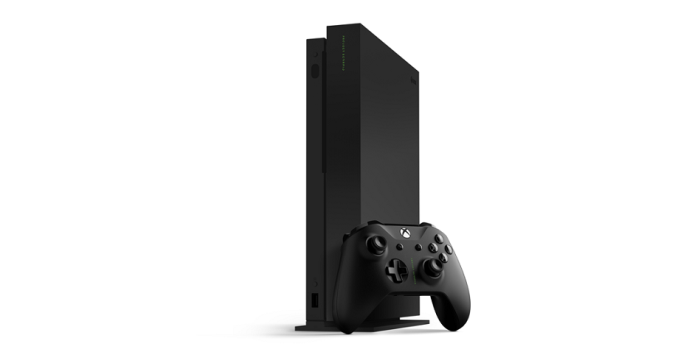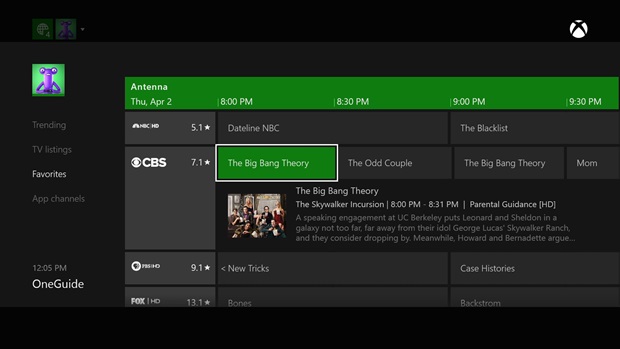The Xbox One X Review: Putting A Spotlight On Gaming
by Brett Howse on November 3, 2017 3:01 AM EST- Posted in
- Consoles
- Microsoft
- Xbox One
- Xbox
- Xbox One X
Power Usage
There’s a lot of performance on tap in the Xbox One X, which never comes with no strings attached. Like the Xbox One S, the APU inside is built on TSMC’s 16 nm FinFET process, which should help keep power usage under control. In addition, the Xbox One X is outfitted with a power supply that Microsoft equates to an 80 Plus Gold unit, which means it should be 90% efficient at 50% load with a 115 V source, and there shouldn’t be too much extra power wasted from the PSU converting AC voltage.
There’s several scenarios we tested for power usage:
Off – Xbox One X is powered off in Energy Savings mode, which means standby mode is disabled.
Standby – Xbox One X is powered off in Instant-On mode, which allows background updating and voice activation enabled (if supported).
Idle – Ethernet connected, no disc in the drive, system idling at dashboard.
Load (UHD BD Playback) – Ethernet connected, UHD Blu-Ray disc in the drive playing Planet Earth II, compared to The Hobbit on Blu-Ray on the original Xbox One.
Load (GoW4) – Ethernet connected, no disc in the drive, playing Gears of War 4 in UHD/HDR.
Load (The Wolf Among Us) – Ethernet connected, no disc in the drive, playing The Wolf Among Us in FHD SDR.
We’ve been able to compare against the original Xbox One, although not the S model as we didn’t have one on hand. The Wolf Among Us was chosen as an older game which caps at 1080p and SDR, and Gears of War 4 shows the power draw at full 4K HDR rendering. The comparison against the original for this game will of course be for the 1080p version though, since that’s the max it supports.
| Power Consumption Comparions | |||||||
| Total System Power | Energy-Saving | Instant-On | Idle | Load (UHD BD) | Load (GoW4) | Load (The Wolf Among Us) | |
| Xbox One | < 2W | 14.2W | 53W | 80W | 107W | 102W | |
| Xbox One X | < 1W | 10W | 56W | 64W | 172W | 101W | |
As with the original Xbox One, when Instant On is disabled, the console is practically fully off. There’s a small amount of draw, but overall, not very much. Most people that use the console are going to likely want it in Instant On mode though, so games and the console can update while the system is off, as well as to provide a much quicker startup time, and games can remain loaded in RAM. In Standby mode, power draw is reasonable at 10 W, which is lower than the original console when it first launched. It’s still a fair bit of power, but when you factor in that it needs to keep 12 GB of GDDR5 memory powered up (among other things), it is not unreasonable to expect this amount of power draw.
Idling at the dashboard draws around 55 W, and to add to that, most non-gaming tasks don’t add very much to this total, if any. If you’re using your Xbox to passthrough HDMI from a cable box, it will take this same power draw. Maybe this would be an impossible pipe dream, but it would be nice to see the Xbox One also pass through HDMI when it is in Standby mode.
Playing back a UHD Blu-Ray (standard Blu-Ray on the original Xbox One) was a tiny bit higher than idle, which is good to see. Some of the draw would be the disc drive itself, but a lot of the playback would be offloaded to fixed function hardware in the media block so it’s not surprising to see it so close to idle.
Clearly gaming on older Xbox One games is not much of a chore for the Xbox One X, since the power draw is only about 50 W over idle. But, when gaming with an Xbox One X Enhanced title, such as Gears of War 4, the power draw jumps significantly to 172 W as the peak observed. This is quite a jump over the original console, and makes the cooling system, which is barely audible even under these loads, even more impressive. Compared to a high-end gaming PC though, the power draw is quite a bit less.












128 Comments
View All Comments
cmdrdredd - Saturday, November 4, 2017 - link
PS4 is doing the same thing.ncsaephanh - Friday, November 3, 2017 - link
Very cool how they basically put a 480's worth of gpu performance and still are able to run the console as quietly as they do. More competition is always a good thing, and I can't wait to see where we are 5 years from now.Drumsticks - Friday, November 3, 2017 - link
Thanks for the review, it was a nice read.Look at that power draw in Gears of War 4 (172W). I know that we can't make direct comparisons, but I wish we could find out if the One X was pegging the GPU at full load during that time. If so, a fully loaded GPU with slightly more hardware (6TF vs like 5.6?), and an 8 core CPU is drawing less power from the wall than an RX 480/580 draws by itself?
It's hard to say for sure unless we could somehow view GPU/CPU load at the same time, but still, how? It's hard to not come to the conclusion that this APU is much more efficient than Polaris. Just how much worse is GloFo versus TSMC Finfet?
InlineV - Friday, November 3, 2017 - link
Microsoft has developed a process for matching the power supply to the CPU/GPU to optimize the power profile at the factory. They haven't released details for how they do that but the results seem to speak for themselves.Stochastic - Friday, November 3, 2017 - link
I just wanted to chime in and say well done! It's great to see Anandtech publish articles on popular consumer tech in a timely fashion. This is the best Xbox One X review I've seen yet--all the details you include are the reason I've continued reading Anandtech after all these years.Brett Howse - Friday, November 3, 2017 - link
Thanks!Wolfpup - Friday, November 3, 2017 - link
Fantastic article, as we expect from Anandtech!So bizarre about that Netflix bug, that they haven't fixed it (how hard can it be?) and replicated it on the PS4 Pro?!?
I love that the Xbox One has at least some backwards compatibility. Love that they're worrying about noise the system makes. Love the use of normal non-proprietary batteries.
Only aspects of the design I don't like are the non-replaceable hard drive (makes me parinoid it's going to die...although IF they do backwards compatibility from here on out, that's less of an issue) and the weird save system. I like being able to manually back up my saves! These cloud servies are flaky in my experience, and that's besides that I might not always want a save on someone's server, nor to use GB of bandwidth backing up saves (and how much space do they give us?)
But mostly it's a great design, and pretty darned exciting.
I'm controlling myself and not buying it until next year, as I've got a huge backlog, and among other things want to get through my PS4 exclusives first, but I'm going to standardize on Xbox One X for the backwards compatibility and controller with normal batteries.
Chad - Friday, November 3, 2017 - link
Great article!!Very impressed with msft right now, it seems they really took their time and properly engineered this thing. Low power, low noise, compact and efficient design packing a ton of power. Both hardware and software (the new OS) are homeruns for a (relatively) low cost. Impressive!
Rufnek - Monday, November 6, 2017 - link
This would have been more impressive if they had attempted to do this for the actual One release.Instead the users got a HUGE console, with external power brick, a useless Kinect and garbage DDR3 ram with a 'special' 32mb bandwidth boost. What a joke that was compared to the smaller, faster, power brick included, GDDR5 console. The X is what M$ should have been aiming for. Hind sight is 20/20
Brett Howse - Friday, November 3, 2017 - link
Yes I'd like them to add removable storage, but I can also understand they want the packaging as clean as they can make it. USB storage is simple and effective.I've never had an issue with game backups to Xbox Live and to be honest I kind of prefer having it synced, especially with Play Anywhere now being a thing.